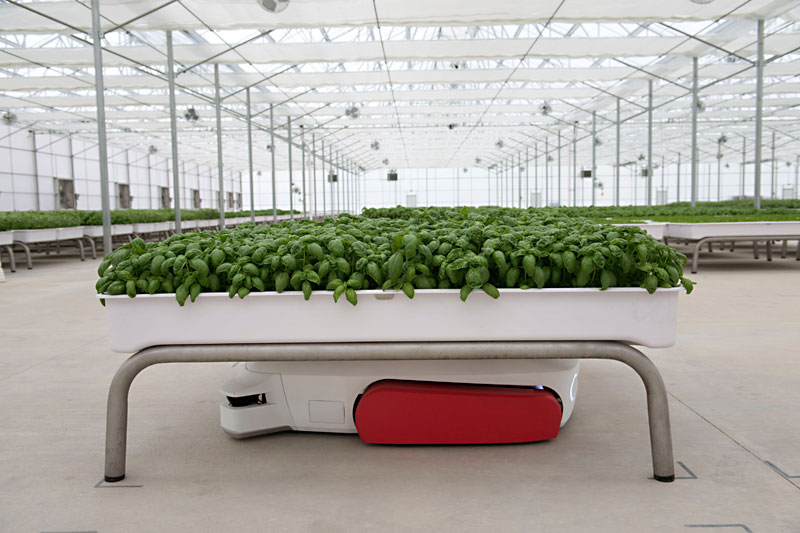Iron Ox Farm Optimizes Indoor Farming With AI and Robots
Lockhart hydroponic farm puts sustainability first
By Lina Fisher, Fri., April 29, 2022

Just a couple streets from Smitty's Market in Lockhart sits Texas' first AI-assisted hydroponic greenhouse. Iron Ox, the confluence of California robotics tech and sustainable farming, broke ground in spring 2021 and held its first grand opening tour for media this April 21, just before Earth Day. "We are in a late-stage climate crisis," began founder and CEO Brandon Alexander, decrying the outsized contribution of industrial agriculture, which uses 70% of global freshwater. Traditional farming practices combined with a changing climate are impacting "where your fresh fruits and vegetables are coming from," said Alexander. "Places like [California's] Central Valley, the salad bowl of the United States, are sinking because of industrial agriculture's overuse of water. Everything from how we plow our land, to the chemicals that we add, to the 2,000 miles that we travel from the farm to the grocery store [feels] broken."
Iron Ox, Alexander's attempt to fix this system, applies his background in robotics and AI at Google to hydroponic farming practices (which use 90% less water than traditional farming), with the goal of increased sustainability and efficiency. In practice, that looks like a greenhouse manned by a fleet of mobile robots named Grover, plus a dash of computer visioning, or "big data for plants" as the Iron Ox team puts it. Plants move through the seeding, germination, and propagation rooms before reaching the main growing room in the greenhouse, where they reach their full potential before harvesting. Each crop – right now Iron Ox grows herbs and greens like basil and lettuce, but their lab facility in California is testing strawberries, tomatoes, and even kohlrabi – is placed into its own module, which can then be picked up by Grover the robot and moved around to nutrient-rich watering stations at will. Computer vision, a type of AI that derives information from images, is used to scan each plant and gather information to specifically cater to its needs and increase yield. Head of Plant Science Paty Romero explains that this allows one greenhouse to grow different kinds of crops, all with different nutrient cocktails – "leafy greens that require higher levels of nitrogen, fruiting crops have potassium and phosphorus … we play with those ratios."
The flexibility of the modules is not only good for plant variety but also makes robot-assisted farming less expensive and more easily scalable, explained head of robotics David Silver, formerly of Waymo, which is the mobility arm of Google's parent company, Alphabet. "The way past approaches would try and scale would be to come up with one fixed process for how they were going to do it, and then build that into the environment. But that means that it's the exact same conditions for every plant, they can only grow one thing at a time, and they can't adjust." With Iron Ox's method, "the upfront is smaller, and there's not anywhere near the same ongoing costs. Once you've invested in something like this, if you want to change the recipe, it's just software."
Iron Ox's commitment to sustainability means the end product's travel time to Texas grocery stores can't exceed a day's drive, hence the ideal location of Lockhart, which can cater to nearby Houston, Austin, and Dallas markets while eliminating the greenhouse gases emitted by the 2,000 miles of travel that most produce requires. The robots themselves are also sustainable: "[They] use a fraction of the power that larger systems in any greenhouse use," says Silver. The robotics team, many of whom are recent Google employees, is currently redesigning the modules to streamline construction and use less stainless steel. "One of the things we're committed to doing is understanding, not just on the individual plant level, but for the entire operation, including construction, what this all means in terms of resources," says Silver.
The Lockhart location is Iron Ox's second facility after the one in Gilroy, California. A third greenhouse is planned, also in Lockhart, at least twice as big as the first. Currently available in California Whole Foods Market locations, Iron Ox produce should pop up in Austin stores by this summer. And if all goes according to plan, this lettuce will be nutrient-optimized, higher yield, and better for the Central Texas environment.
Got something to say on the subject? Send a letter to the editor.








